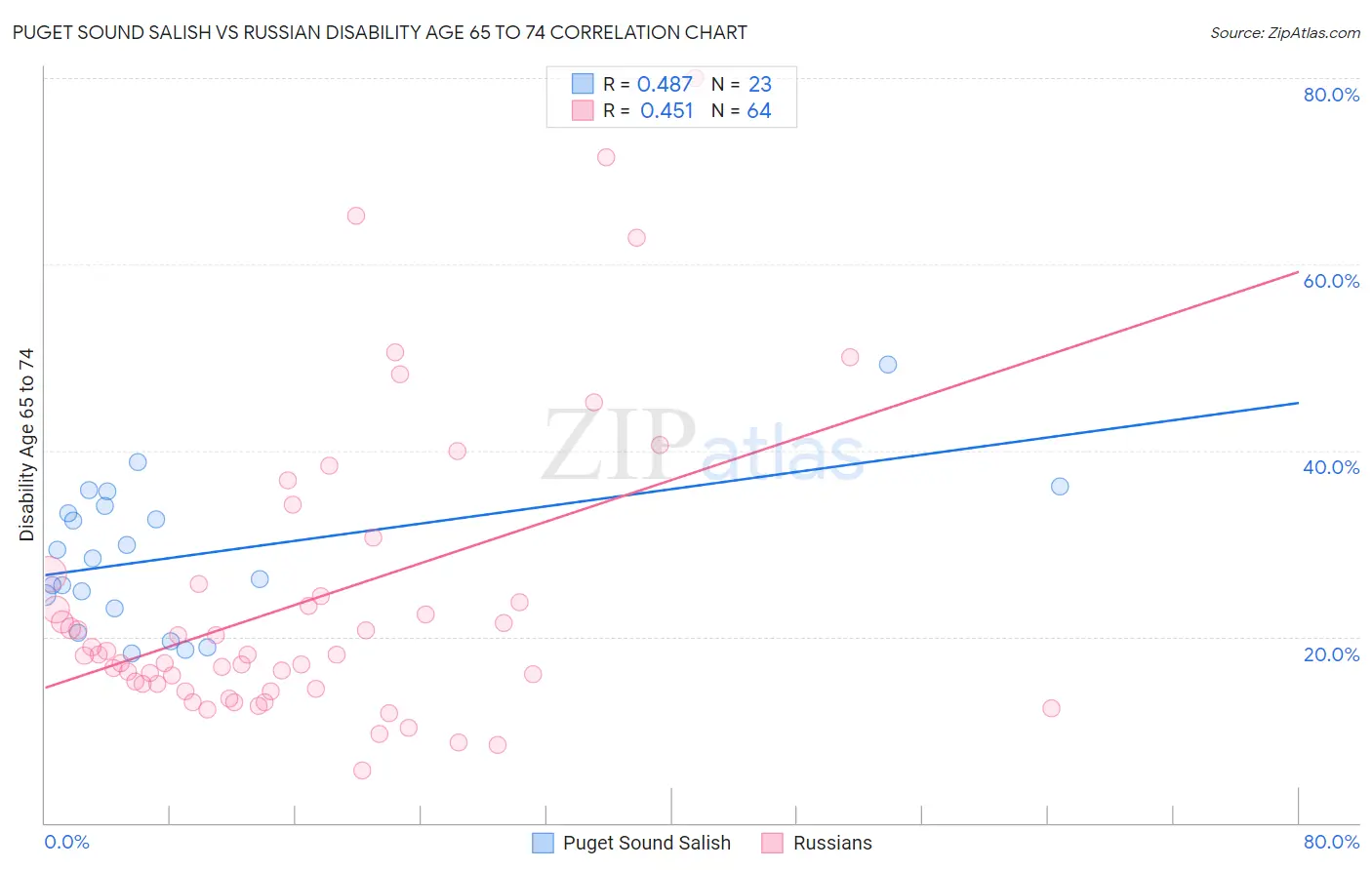Puget Sound Salish vs Russian Disability Age 65 to 74
COMPARE
Puget Sound Salish
Russian
Disability Age 65 to 74
Disability Age 65 to 74 Comparison
Puget Sound Salish
Russians
27.2%
DISABILITY AGE 65 TO 74
0.0/ 100
METRIC RATING
304th/ 347
METRIC RANK
21.2%
DISABILITY AGE 65 TO 74
99.8/ 100
METRIC RATING
38th/ 347
METRIC RANK
Puget Sound Salish vs Russian Disability Age 65 to 74 Correlation Chart
The statistical analysis conducted on geographies consisting of 46,105,996 people shows a moderate positive correlation between the proportion of Puget Sound Salish and percentage of population with a disability between the ages 65 and 75 in the United States with a correlation coefficient (R) of 0.487 and weighted average of 27.2%. Similarly, the statistical analysis conducted on geographies consisting of 510,598,178 people shows a moderate positive correlation between the proportion of Russians and percentage of population with a disability between the ages 65 and 75 in the United States with a correlation coefficient (R) of 0.451 and weighted average of 21.2%, a difference of 28.4%.

Disability Age 65 to 74 Correlation Summary
| Measurement | Puget Sound Salish | Russian |
| Minimum | 18.2% | 5.7% |
| Maximum | 49.3% | 80.0% |
| Range | 31.1% | 74.3% |
| Mean | 28.7% | 23.9% |
| Median | 28.4% | 18.1% |
| Interquartile 25% (IQ1) | 23.1% | 14.7% |
| Interquartile 75% (IQ3) | 34.1% | 25.0% |
| Interquartile Range (IQR) | 11.0% | 10.4% |
| Standard Deviation (Sample) | 7.7% | 15.8% |
| Standard Deviation (Population) | 7.5% | 15.7% |
Similar Demographics by Disability Age 65 to 74
Demographics Similar to Puget Sound Salish by Disability Age 65 to 74
In terms of disability age 65 to 74, the demographic groups most similar to Puget Sound Salish are Mexican (27.2%, a difference of 0.10%), Tlingit-Haida (27.1%, a difference of 0.12%), Central American Indian (27.1%, a difference of 0.18%), Immigrants from Mexico (27.1%, a difference of 0.19%), and Black/African American (27.3%, a difference of 0.50%).
| Demographics | Rating | Rank | Disability Age 65 to 74 |
| Fijians | 0.0 /100 | #297 | Tragic 27.0% |
| Immigrants | Yemen | 0.0 /100 | #298 | Tragic 27.0% |
| Potawatomi | 0.0 /100 | #299 | Tragic 27.0% |
| Immigrants | Dominican Republic | 0.0 /100 | #300 | Tragic 27.0% |
| Immigrants | Mexico | 0.0 /100 | #301 | Tragic 27.1% |
| Central American Indians | 0.0 /100 | #302 | Tragic 27.1% |
| Tlingit-Haida | 0.0 /100 | #303 | Tragic 27.1% |
| Puget Sound Salish | 0.0 /100 | #304 | Tragic 27.2% |
| Mexicans | 0.0 /100 | #305 | Tragic 27.2% |
| Blacks/African Americans | 0.0 /100 | #306 | Tragic 27.3% |
| Ute | 0.0 /100 | #307 | Tragic 27.3% |
| Sioux | 0.0 /100 | #308 | Tragic 27.3% |
| Yaqui | 0.0 /100 | #309 | Tragic 27.4% |
| Shoshone | 0.0 /100 | #310 | Tragic 27.4% |
| Menominee | 0.0 /100 | #311 | Tragic 27.4% |
Demographics Similar to Russians by Disability Age 65 to 74
In terms of disability age 65 to 74, the demographic groups most similar to Russians are Israeli (21.2%, a difference of 0.0%), Immigrants from Switzerland (21.1%, a difference of 0.11%), Argentinean (21.2%, a difference of 0.18%), Bulgarian (21.1%, a difference of 0.30%), and Latvian (21.2%, a difference of 0.35%).
| Demographics | Rating | Rank | Disability Age 65 to 74 |
| Immigrants | Northern Europe | 99.9 /100 | #31 | Exceptional 21.0% |
| Turks | 99.9 /100 | #32 | Exceptional 21.0% |
| Immigrants | Argentina | 99.9 /100 | #33 | Exceptional 21.1% |
| Immigrants | Sri Lanka | 99.9 /100 | #34 | Exceptional 21.1% |
| Bulgarians | 99.9 /100 | #35 | Exceptional 21.1% |
| Immigrants | Switzerland | 99.8 /100 | #36 | Exceptional 21.1% |
| Israelis | 99.8 /100 | #37 | Exceptional 21.2% |
| Russians | 99.8 /100 | #38 | Exceptional 21.2% |
| Argentineans | 99.8 /100 | #39 | Exceptional 21.2% |
| Latvians | 99.8 /100 | #40 | Exceptional 21.2% |
| Immigrants | Austria | 99.8 /100 | #41 | Exceptional 21.2% |
| Macedonians | 99.7 /100 | #42 | Exceptional 21.3% |
| Immigrants | Croatia | 99.7 /100 | #43 | Exceptional 21.3% |
| Estonians | 99.7 /100 | #44 | Exceptional 21.4% |
| Asians | 99.7 /100 | #45 | Exceptional 21.4% |